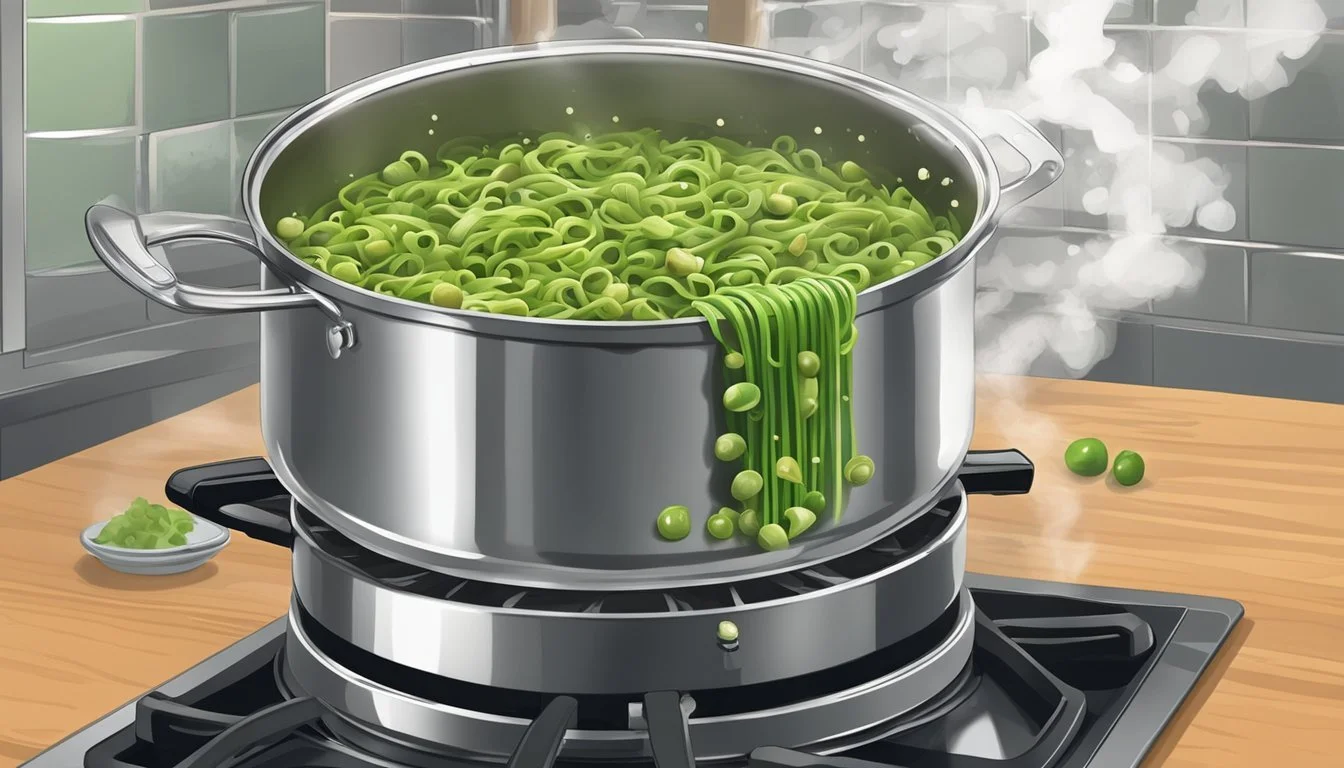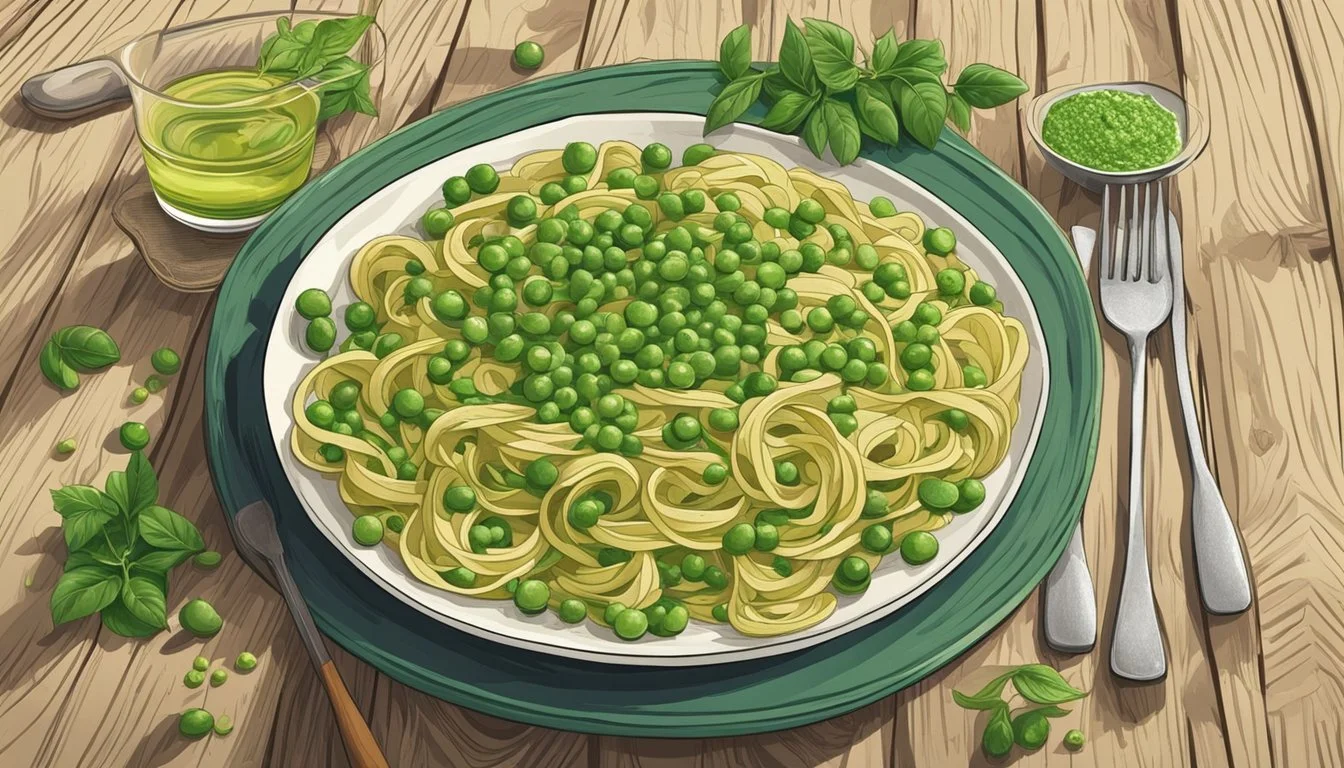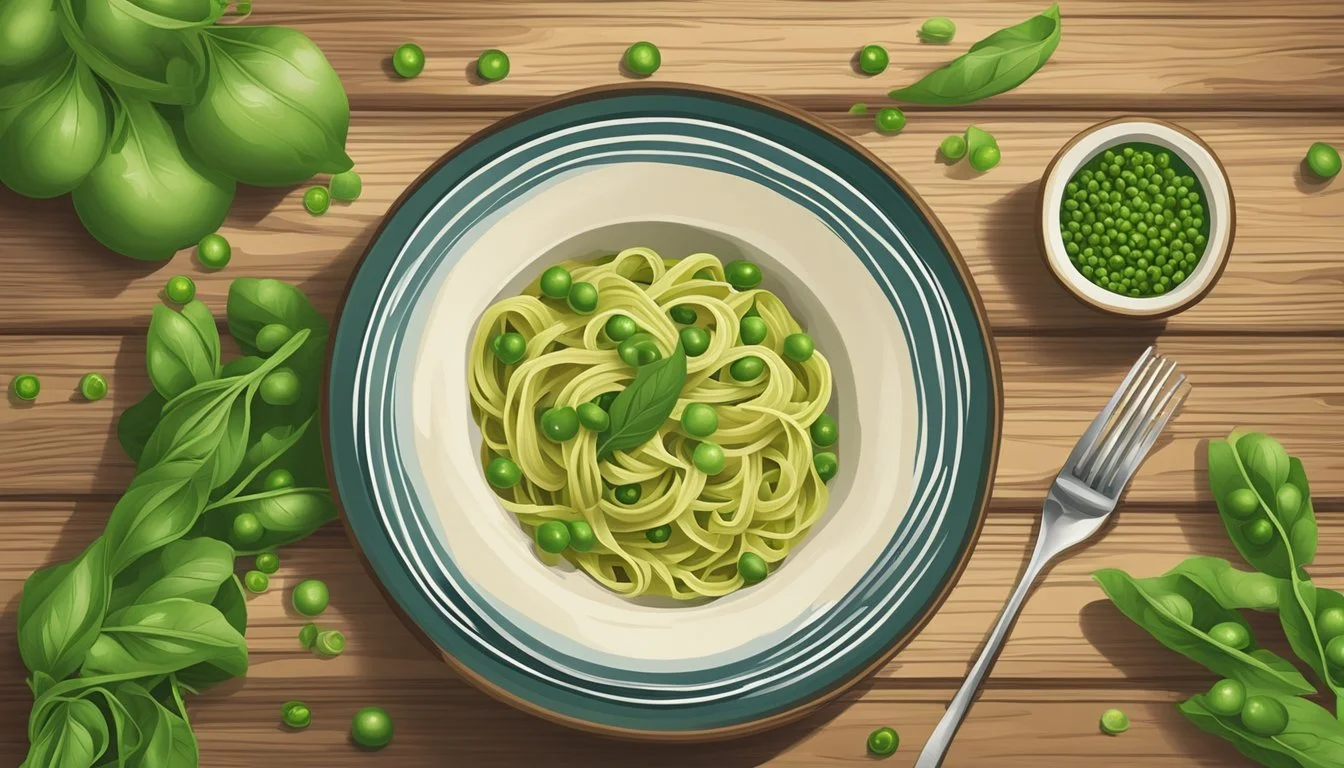Best Way to Reheat Fettuccine with Pesto and Peas
Ensuring Colorful, Tasty Leftovers
Reheating fettuccine with pesto and peas so it retains not only its taste but also its vibrant colors can be a culinary challenge. Pesto, in particular, is delicate and can darken or split when exposed to high heat. It is crucial to employ methods that gently warm the dish, preserving the bright green hue of the pesto and the fresh color of the peas without overcooking the pasta (What wine goes well with pasta?).
The key to a successful reheating is to distribute heat evenly and to incorporate moisture to prevent the pasta from drying out. Fettuccine, with its wide, flat surface, also tends to stick together, making it imperative to use techniques that maintain its individual strands.
Choosing the right method — whether on the stovetop, in the oven, or using the microwave — depends on factors such as the quantity of pasta, the available equipment, and the time constraints. In all cases, retaining the textural integrity and the aesthetic appeal of fettuccine with pesto and peas is the goal, ensuring the reheated dish closely resembles its freshly prepared state.
Understanding Pesto Pasta
Pesto pasta combines the vibrant flavors of fresh herbs and the comforting texture of noodles, evolving into a dish that is both colorful and flavorful.
Components of Pesto
Pesto traditionally consists of fresh basil leaves, pine nuts, Parmesan cheese, garlic, and olive oil. Each ingredient contributes to its distinct taste and texture. The basil provides a fresh and slightly peppery flavor, while the pine nuts offer a unique texture and creaminess to the sauce. Parmesan cheese adds a salty and sharp profile, complementing the boldness of garlic, and olive oil acts as a binder, bringing all the components together to form a smooth paste.
Fresh basil: The key element for authentic flavor.
Pine nuts: Can be replaced with other nuts for a different twist, but traditionally used for creaminess.
Cheese: Parmesan or Pecorino Romano is customary, providing a necessary saltiness.
Garlic: Offers an aromatic kick, balance is critical.
Olive oil: Ensures a silky texture.
Types of Pasta Suitable for Reheating
Not all noodles are ideal for reheating with pesto. When considering leftovers, the objective is to maintain the pasta's integrity without compromising the bold colors and flavors of the pesto.
Suitable types of pasta include:
Thick noodles (e.g., Fettuccine, Tagliatelle): They reheat well while retaining their al dente texture.
Short noodles (e.g., Penne, Farfalle): Good for even distribution of pesto.
The selection primarily includes shapes that don't clump together easily and have a structure that holds onto the pesto even after reheating. Avoid overly thin pastas that may become mushy or pastas with complex shapes where the sauce may dry out or get trapped during the reheating process.
Storing Leftover Pesto Pasta
Proper storage of leftover pesto pasta will maintain its quality and extend its shelf life. Adherence to optimal refrigeration and freezing practices is crucial for preserving the pasta's vibrant colors and flavors.
Refrigeration Tips
When storing leftover pesto pasta in the refrigerator, one should employ an airtight container to prevent exposure to air and moisture, which can degrade quality. To ensure cold pesto pasta retains its texture:
Cool the pasta to room temperature before refrigerating to prevent condensation.
Transfer to an airtight container within two hours of cooking to minimize the risk of bacterial growth.
Consume refrigerated pesto pasta within 3-5 days for the best quality.
Freezing Guidelines
For longer storage, the freezer is a viable option. The following steps should be taken to freeze leftover pasta correctly:
Portion the pasta into single servings to facilitate easy thawing.
Entrapment of air should be minimized by using freezer-safe bags or containers.
A layer of plastic wrap directly on the surface of the pesto pasta can prevent freezer burn.
Label each container with the date to ensure the pasta is used within a 3-month period for optimal freshness.
By adhering to these guidelines, one can extend the enjoyment of their pesto pasta while maintaining its intended flavor and appearance.
Reheating Methods Overview
When reheating fettuccine with pesto and peas to preserve its vibrant colors and flavors, one can employ various methods including stove, microwave, or oven. Each method comes with its own set of advantages and drawbacks.
Pros and Cons of Using a Stove
Pros:
Stovetop reheating allows for precise temperature control, which is crucial for preventing the pesto from separating and maintaining the peas' bright color.
The pasta can be stirred frequently, which promotes even heating and helps to refresh the texture of the fettuccine.
Cons:
It's a slower method compared to using a microwave.
Stovetop reheating can result in the pasta absorbing too much oil or water if not carefully managed, potentially causing a soggy texture.
Pros and Cons of Using a Microwave
Pros:
The microwave offers a quick reheating option for fettuccine with pesto and peas, making it suitable for those in a hurry.
Microwave reheating is straightforward and requires fewer utensils, resulting in less cleanup.
Cons:
There's a higher risk of uneven heating, which can lead to hotspots and potentially a compromised texture and taste of the dish.
The vibrant colors of the pesto and peas can fade if overheated due to the high temperatures that can build quickly.
Pros and Cons of Using an Oven
Pros:
Oven reheating is generally considered the best way to reheat as it can provide a uniform heat that is gentle on the delicate ingredients like pesto and peas.
The oven method allows for large quantities to be reheated at once, which is efficient for bigger servings.
Cons:
It is the most time-consuming method, requiring a preheat phase and a longer heating time to reach desired temperatures.
Without proper covering, there's a risk of drying out the pasta and causing the pesto to lose its creaminess.
Step-by-Step Reheating on the Stovetop
Reheating fettuccine with pesto and peas on the stovetop can preserve the pasta's texture and vibrant colors. The reader should ensure to use gentle heat and introduce moisture carefully to avoid drying out the pasta.
Preparing the Skillet
They begin by placing a skillet on the stovetop over low to medium heat. It's crucial to use a skillet that is wide enough to accommodate the leftover pasta without overcrowding, which ensures even reheating. A non-stick skillet is preferred to prevent the pasta from sticking to the bottom.
Adding Moisture to the Pasta
Once the skillet is warm, they should add a small amount of water, olive oil, or butter to the skillet to reintroduce moisture. This prevents the fettuccine from drying out, maintaining its tender texture.
Liquid Options:
Water: 1-2 tablespoons
Olive oil: 1 tablespoon
Butter: 1 tablespoon
They should then gently mix in the fettuccine with the liquid to evenly coat the pasta and prevent it from sticking together.
Finishing Touches
The pasta should be cooked on low heat for a few minutes, stirring consistently to ensure it's heated through and to preserve its vibrant green color from the pesto. They can adjust the temperature as needed to prevent any sizzling or popping — an indication that the skillet is too hot. The goal is to warm the pasta through without overcooking it, which would compromise the pasta's quality. Once the pasta appears glossy, indicating that it has been coated well with the oil or butter, and is sufficiently warm, it's ready to be served.
Microwave Reheating Technique
When reheating fettuccine with pesto and peas in the microwave, one must consider the right cookware, precise microwave settings, and techniques to maintain the pasta's consistency and vibrant color.
Selecting the Right Dish
It is essential to choose a microwave-safe dish that can accommodate the leftovers without overcrowding. A dish with a lid is preferable. If a lid is not available, one can cover the dish with microwave-safe plastic wrap or a damp paper towel to trap moisture, which is crucial for preventing the pasta from drying out.
Adjusting Microwave Settings
Adjusting the microwave settings correctly is a key step. One should set the microwave to medium heat and reheat the pasta at one-minute intervals. It's important to check the pasta after each interval, stirring to ensure even heating and to prevent hotspots.
Initial Reheating: Begin with one minute.
Subsequent Checks: Continue with 15-second increments after the initial minute.
Maintaining Pasta Consistency
Maintaining the consistency of the fettuccine as well as the brightness of the pesto and peas is important. To achieve this, one can:
Add Moisture: Before starting, stir in a small amount of water or olive oil—just a tablespoon or two—to replenish lost moisture and prevent sticking.
Stir Gently: After each heating interval, gently stir to distribute heat and maintain texture.
Avoid Overheating: Overheating can make the pasta mushy and cause the vibrant green hues of the pesto and peas to fade.
By following these careful steps, one can achieve a rejuvenated fettuccine with pesto and peas that retains its appetizing appearance and texture.
Oven Reheating Process
To effectively reheat fettuccine with pesto and peas while preserving its vibrant colors and maintaining a slight crispiness, one should follow specific steps for oven reheating. This method ensures that the pasta is heated evenly and retains its appealing textures.
Preparing the Oven-Safe Dish
The first step involves selecting an oven-safe dish that can comfortably hold the leftover pesto pasta. One should lightly coat the base of the dish with olive oil or a small amount of leftover pesto to prevent sticking. Then, the fettuccine with pesto and peas should be evenly distributed in the dish to ensure consistent heating.
Layering with Aluminum Foil
Next, cover the oven-safe dish securely with aluminum foil. This will help to lock in moisture, avoiding drying out the pasta. Ensure the foil is sealed tightly over the dish's edges to retain the vibrant flavors and colors during the reheating process.
Oven Time and Temperature
Set the oven to a moderate temperature of 350 degrees Fahrenheit. Place the covered dish in the center of the oven, allowing for even heat distribution. Reheat the fettuccine for approximately 20 minutes. The gentle heat encourages the flavors to meld without sacrificing the pasta's texture. After removing the dish from the oven, one should stir the pasta to check for even reheating, taking care not to break the delicate strands or smash the peas.
Maintaining Texture and Flavor
When reheating fettuccine with pesto and peas, one must prioritize methods that retain the pasta's firm texture and the pesto's bright, herbaceous flavor without allowing the dish to dry out or overcook.
Avoiding Overcooking
To prevent overcooking, which leads to a mushy texture, one should reheat the fettuccine gently. For oven methods, the pasta should be covered with foil and heated at 350°F (175°C) no longer than 10 minutes. In a microwave, heating in short bursts and stirring between intervals can help maintain an al dente texture.
Oven Method:
Preheat to 350°F (175°C).
Add a splash of water or olive oil to the dish.
Cover with foil and heat for 10 minutes.
Microwave Method:
Use a microwave-safe dish.
Cover with a paper towel.
Heat on high power in 1-minute intervals, stirring in between.
Adding Freshness with Ingredients
Incorporating fresh ingredients can revitalize the dish. A dollop of fresh pesto or a sprinkling of Parmesan cheese can enhance flavor and add moisture back into the pasta. If using store-bought pesto, one can add pine nuts, fresh basil leaves, or a touch of garlic to brighten the dish.
Refreshing with Extras:
Fresh pesto: Add to taste for vibrancy.
Pine nuts: Lightly toast and sprinkle on top for crunch.
Fresh basil: Tear leaves and incorporate for a burst of color and aroma.
Garlic: Mince and mix in for a bold flavor.
Parmesan: Grate over pasta to restore rich, cheesy notes.
Safety and Health Considerations
When reheating fettuccine with pesto and peas, it's crucial to address bacterial growth and ensure the dish reaches a safe temperature for consumption to prevent foodborne illnesses.
Addressing Bacterial Concerns
Bacteria can thrive in the "danger zone" between 40°F (4°C) and 140°F (60°C). To mitigate the risk, the fettuccine with pesto and peas should not be left at room temperature for more than two hours. Before reheating, if the pasta has been stored improperly or for an extended time, it's safest to discard it to prevent the risk of bacterial contamination.
Ensuring Proper Food Temperature
The dish should be reheated to an internal temperature of 165°F (74°C) to ensure that any potential bacteria are killed. Use a food thermometer to check the temperature. Here's how to effectively reach the desired temperature:
Microwave: Cover the dish and reheat in intervals, stirring in between to distribute the heat evenly.
Oven: Preheat the oven to 350°F (175°C), cover the pasta with foil, and heat for about 10 minutes, then check the temperature.
Stovetop: Warm through over low heat, stirring frequently until it reaches the proper temperature.
Serving Suggestions
When presenting fettuccine with pesto and peas, one has to consider both accompaniments and presentation to elevate the experience. The vibrant colors of the dish are best preserved when served immediately after reheating, and pairing with complementary flavors will ensure a delightful meal.
Accompaniments
To enhance the flavor profile of fettuccine with pesto and peas, consider:
Cheese: A sprinkle of grated cheese, such as Parmesan, adds a savory depth.
Olive Oil: A drizzle of high-quality extra virgin olive oil can enrich the dish's flavor.
Proteins: For a heartier meal, adding grilled chicken slices or sautéed seafood like shrimp complements the pesto.
Nuts: Toasted almonds or pine nuts offer a crunchy texture contrast.
Vegetables: Fresh cherry tomatoes, either whole or halved, can add a refreshing acidity and burst of color.
Presentation Tips
The presentation of fettuccine with pesto and peas plays a significant role in the dining experience:
Dish Color: Serve on a plain white plate to make the colors pop.
Portioning: Twirl the fettuccine to one side and top with peas for a composed look.
Garnish: A few whole peas, a sprig of basil, and a light dusting of grated cheese can make the dish visually appealing.
Serving Temperature: Ensure the dish is warm but not too hot, to maintain the integrity of the pesto's vibrant green hue.
Conclusion
When reheating fettuccine with pesto and peas, the aim is to preserve not just the heat but also the vibrant green of the pesto and the integrity of the peas. While personal preference dictates the method one may choose, using a non-stick skillet or an oven can yield the best results. These techniques prevent sticking, ensure even heating, and maintain the dish's colors and flavors.
In a Skillet:
Start with a non-stick skillet on medium heat.
Add a small amount of olive oil to coat the bottom.
Place the pasta into the skillet, stirring gently until warmed through.
The process should take approximately 5-7 minutes.
In the Oven:
Preheat your oven to 350°F (175°C).
Toss the pasta lightly with olive oil or water in an oven-safe dish.
Cover with foil to keep moisture in.
Bake for about 10 minutes, then stir and check for warmth.
Additional Tips:
Microwave reheating is not recommended for pesto as it can cause the sauce to separate and the peas to lose their texture.
Adding a bit of fresh pesto can revive the flavors.
Be attentive to not overheat, as high heat can discolor the pesto.
Each reheating method brings the dish closer to its initial delight, with careful attention ensuring that the fettuccine with pesto and peas looks as good as it tastes. Remember, these tips and tricks are guidelines to suit a variety of personal preferences and kitchen setups.









